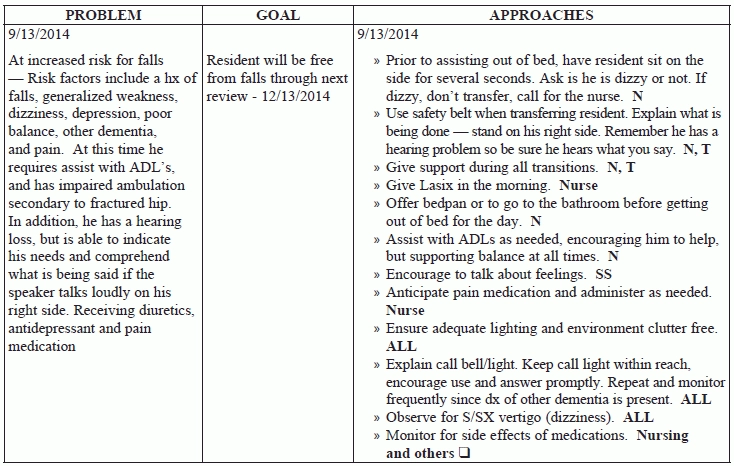Heed Expert Tips To Improve Your Care Planning
Learn the right way to care plan from this example.
If you keep your care planning process focused on the unique needs of the individual resident, you’ll find that the care plan will be obvious and not the difficult task facing staff in the long-term care environment. Here’s how to individualize — and, as a result, optimize — your care planning and Care Area Assessment (CAA) process.
As explored in last month’s issue of MDS Alert (“Follow 5 Steps To Perfect Your CAA Process & Care Planning,” page 25), following the five steps to the CAA process will enlighten staff to each resident’s needs and reveal the resident-specific strengths, deficits and wishes, says Marilyn Mines, RN, BC, RAC-CT, MDS Alert consulting editor and senior manager of clinical services for FROST Healthcare in Deerfield, Ill. Of course, the care planning process begins with the completion of the MDS.
Care Plan for the Unique Individual
Key: Approach CAA completion as different for each resident — don’t use the “factory-line” check-off system for each care area, Mines advises. “Thinking of each resident as an individual, a person with unique characteristics and strengths, will allow not only the CAA to be more informative, but will also help you to consider the person as a ‘whole’ when developing the care plan.”
First, analyze the information garnered from completing the CAA. If you complete this part of the RAI process truly considering the resident’s individuality, you’ll outline issues specific to the person.
Bottom line: “It is not necessary to rack your brain to come up with a good care plan,” Mines says. “Just use the information you have and put it in a care plan format. Even though several residents may trigger the same CAA, the results identified during the CAA analysis should be different and used to develop an appropriate care plan for the individual.”
Decide Whether to Address the Issue
Strategy: The assessor must determine whether to care plan an issue or not, and must then document the reasons for this decision, Mines explains. The critical-thinking part of the RAI process is identifying care plan issues, basing goals and interventions on the CAA findings.
“Second, using this information, format the summary from the CAA and write the care plan,” Mines instructs. “Keep in mind that most care plans will include management of risks that may have potential negative consequences.”
Learn to Care Plan Falls with This Scenario
Mines provides the following example:
Mr. Smith was admitted to your facility after repair of a fractured hip, which triggered the Falls CAA. An intensive review of the CAA identifies a variety of conditions and situations. The resident has a history of falls, difficulty maintaining good sitting and standing balance, impaired balance during transitions, and gait problems.
Mr. Smith is taking medications which include antidepressants, diuretics, narcotics, and other medications that may cause lethargy and confusion (the CAA supporting documentation column includes the specific medications). Additional diagnoses include Atrial Fibrillation, CHF, HTN, other dementia, and depression. Based on family and resident discussions, Mr. Smith has experienced a decrease in function and muscle weakness. He also has hearing loss and episodes of dizziness. He experiences pain constantly at an intensity of “5.”
Problem: Mr. Smith’s family wants to take him home, but they are concerned about his decreased function and weakness, as well as the recent fall, depression and forgetfulness.
Solution: The interdisciplinary team will develop a care plan to decrease the identified risks, which is essential to the long-term goal of preventing subsequent falls. The problem statement is clear: This resident has an increased risk for future falls. You should clearly indicate all the risk factors with Mr. Smith’s current functional level.
The goal is prevention of further falls. And you would base the approaches on the risk factors, this resident specific framework, identified on the CAA review detail. Here is the care plan for this scenario:


